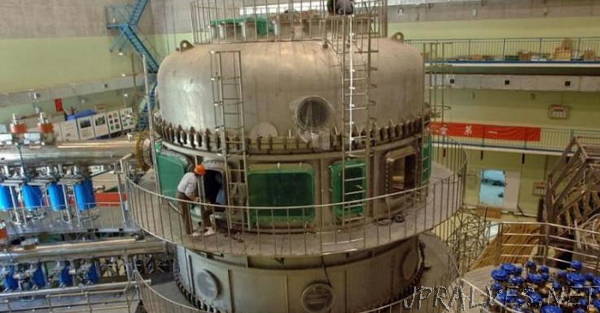
“China’s “artificial sun” has reached a temperature of 180 million ºF with a heating power of 10 megawatts, according to scientists at the Chinese Academy of Sciences’ Institute of Plasma Physics, where the experiment was conducted. That’s six times hotter than the center of the sun. The device, the Experimental Advanced Superconducting Tokamak (EAST), is built to harness the energy of nuclear fusion, the same process that powers stars.
Most living things depend on nuclear fusion. If the sun stopped working, so would we. But fusion may also offer a clean energy solution into the future.
For a fusion reaction to occur, two atomic nuclei merge under extremely high pressures and temperatures topping 270 million ºF. Once merged, they release masses of energy that can be captured and potentially used to power cities. Unlike burning fossil fuels, there are zero carbon emissions. And unlike nuclear fission, it’s relatively safe.
“The news from EAST is very exciting,” William Dorland, a physicist who studies nuclear fusion reactors at the University of Maryland, told Digital Trends. The result is not unprecedented — the world record temperatures are up to five times hotter — but Dorland, who was not involved in the research, said the result is exhilarating, particularly due to the device’s design. It’s built for “magnetic confinement fusion.”
“The challenge for magnetic confinement fusion is to produce high temperatures in the fuel while also maintaining high density and excellent thermal insulation,” Dorland said. “Achieving these three performance goals simultaneously is seriously hard.”
Nuclear fusion is tough to start and even harder to maintain. It’s difficult to build a reactor capable of containing the immense pressure and temperature the reaction demands. But fusion labs and startups around the world have begun to turn the tide, reports the BBC, and see a fusion-powered future on the horizon.
“This is the ‘SpaceX moment’ for fusion,” Christofer Mowry, chief executive of a Canadian company called General Fusion, told the BBC. “It’s the moment when the maturation of fusion science is combined with the emergence of 21st Century enabling technologies like additive manufacturing and high-temperature superconductors. Fusion is no longer ‘30 years away.’”
There are still plenty of milestones ahead. Creating a reactor that can confine the liquid and scaling the device up to a commercially viable size are among the two biggest obstacles.”
Link to article
